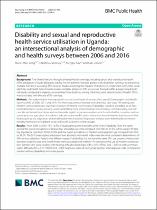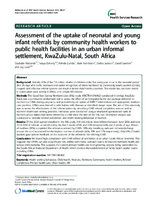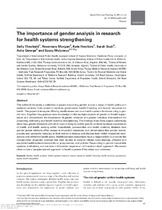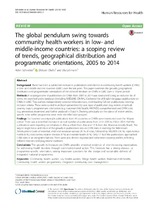Disability and sexual and reproductive health service utilisation in Uganda: an intersectional analysis of demographic and health surveys between 2006 and 2016
Date
2022Author
Zinszer, Kate
Yuan, Mengru
Zarowsky, Christina
Mac‑Seing, Muriel
Metadata
Show full item recordAbstract
Background: The United Nations through universal health coverage, including sexual and reproductive health
(SRH), pledges to include all people, leaving no one behind. However, people with disabilities continue to experience
multiple barriers in accessing SRH services. Studies analysing the impacts of disability in conjunction with other social
identities and health determinants reveal a complex pattern in SRH service use. Framed within a larger mixed methods
study conducted in Uganda, we examined how disability, among other key social determinants of health (SDH),
was associated with the use of SRH services.
Methods: We analysed data from repeated cross-sectional national surveys, the Uganda Demographic and Health
Surveys (DHS) of 2006, 2011, and 2016. The three outcomes of interest were antenatal care visits, HIV testing, and
modern contraception use. Our main exposure of interest was the type of disability, classified according to six functional
dimensions: seeing, hearing, walking/climbing steps, remembering/concentrating, communicating, and selfcare.
We performed descriptive and multivariable logistic regression analyses, which controlled for covariates such as
survey year, sex, age, place of residence, education, and wealth index. Interaction terms between disability and other
factors such as sex, education, and wealth index were explored. Regression analyses were informed by an intersectionality
framework to highlight social and health disparities within groups.
Results: From 2006 to 2016, 15.5-18.5% of study participants lived with some form of disability. Over the same
period, the overall prevalence of at least four antenatal care visits increased from 48.3 to 61.0%, while overall HIV testing
prevalence rose from 30.8 to 92.4% and the overall prevalence of modern contraception use increased from 18.6
to 34.2%. The DHS year, highest education level attained, and wealth index were the most consistent determinants of
SRH service utilisation. People with different types of disabilities did not have the same SRH use patterns. Interactions
between disability type and wealth index were associated with neither HIV testing nor the use of modern contraception.
Women who were wealthy with hearing difficulty (Odds Ratio (OR) = 0.15, 95%CI 0.03 – 0.87) or with communication
difficulty (OR = 0.17, 95%CI 0.03 – 0.82) had lower odds of having had optimal antenatal care visits compared to
women without disabilities who were poorer.
Collections
Related items
Showing items related by title, author, creator and subject.
-
Assessment of the uptake of neonatal and young infant referrals by community health workers to public health facilities in an urban informal settlement, KwaZulu-Natal, South Africa
Nsibande, Duduzile; Doherty, Tanya; Ijumba, Petrida; Tomlinson, Mark; Jackson, Debra; Sanders, David; Lawn, Joy (Biomed CentralBiomed Central, 2013)Background: Globally, 40% of the 7.6 million deaths of children under five every year occur in the neonatal period (first 28 days after birth). Increased and earlier recognition of illness facilitated by community health ... -
The importance of gender analysis in research for health systems strengthening
Theobald, Sally; Morgan, Rosemary; Hawkins, Kate; Ssali, Sarah; George, Asha S.; Molyneux, Sassy (Oxford University Press, 2017)This editorial discusses a collection of papers examining gender across a range of health policy and systems contexts, from access to services, governance, health financing, and human resources for health. The papers ... -
The global pendulum swing towards community health workers in low- and middle-income countries: A scoping review of trends, geographical distribution and programmatic orientations, 2005 to 2014
Schneider, Helen; Okello, Dickson; Lehmann, Uta (BioMed Central, 2016)BACKGROUND: There has been a substantial increase in publications and interest in community health workers (CHWs) in low- and middle-income countries (LMIC) over the last years. This paper examines the growth, geographical ...




